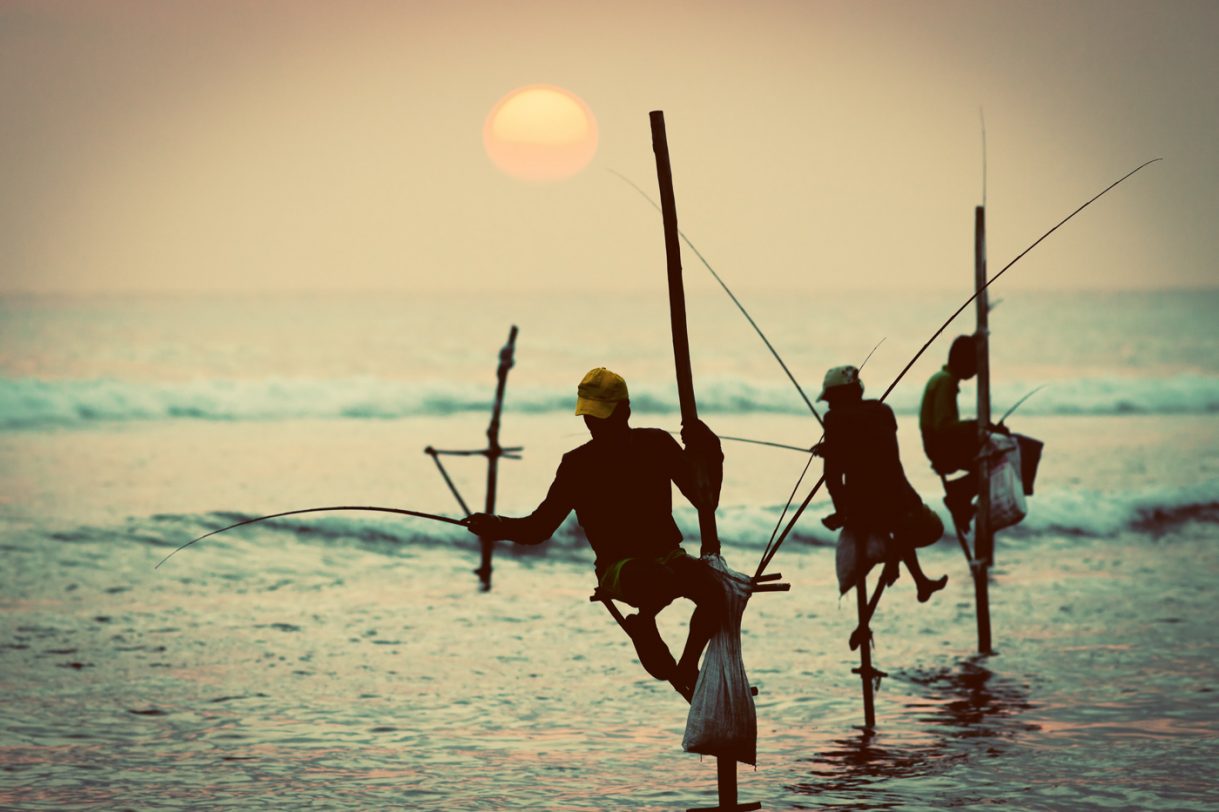Galle has it all: historic colonial sights, meditative temples, sandy beaches and rivers teeming with wildlife, all of which make this southern seaside escape a must-see on most Sri Lankan travel itineraries. Its origins are ancient; as a seaport it dates back millennia. Cinnamon has been shipped from here for a thousand years and it was to these shores and Galle’s natural harbour that King Solomon came for ivory, peacocks and other island valuables. Following Portuguese and then Dutch colonisation, this was a hotspot on the spice trading map and the main port for Sri Lanka for 200 years, until the arrival of British, who shifted the main port to Colombo.
Today Galle is a tale of two cities: the bustling New Town feels worlds away from the frozen-in-time colonial-era nostalgia of its Old Town, secreted away within the coral and granite walls of the seventeenth-century Dutch fort overlooking the ocean. Many come to Galle just to wander the quiet, quaint streets of this living museum and UNESCO World Heritage Site, yet there is much more to this place, especially for lovers of wildlife. Combining tours of cultural wonders with nature spectacles like blue whale-watching, bike rides and river trips, here is our ultimate four-day insider’s guide to Galle, giving you where to go, stay, eat, drink and see in this unique city.
DAY ONE AM
11:00am – We arrive at Jetwing Lighthouse hotel, one of the country’s architectural treasures and a luxurious base for exploring Galle. Sitting on a coastal promontory a mile or so west of town, the hotel is close enough to be super-convenient and yet has enough distance to feel like a place of escape and relaxation. The building was designed by Sri Lanka’s master-architect, the late, great Geoffrey Bawa and many of his hallmarks are in evidence here: long, linear, pillared corridors, spacious reflecting pools, interlinked courtyards and windows framing incredible views of sea, sand and sky. His friend, artist Laki Senanayake, crafted the hotel’s spectacular spiralled entry staircase. Like a 3-D Cubist masterpiece, it is a two-floor balustrade depicting a battle for the Sinhalese kingdom, vividly brought to life in copper and bronze warriors. There’s no finer staircase in Asia.
1:30pm – The hotel has a fabulous spa offering ayurveda, the ancient form of Indian medicine, and I head there straight-away to squeeze in a treatment. The menu is diverse: facials, massages, scrubs and wraps, but I settle on ‘Marma’, a signature massage using ayurveda oils followed by a scrub of powdered herbs. After our 2.5-hour drive from Colombo, I soon drift off, calmed by the cocktail of healing hands, crashing waves and swooshing palms.
3.30pm – As the heat of the day starts to dissipate, Galle Fort calls. We grab a local tuk tuk to take us the two kilometres to the old town for a walking tour. We start at the Dutch Reformed Church (a magnificent gabled building with tombstones bearing Dutch names) and wander down Church Street to a pretty Anglican Church. Then we turn left down Queen Street, flanked by the ochre-coloured Old Dutch Warehouses (home to the town’s National Maritime Museum) and the Old Dutch Gate, which displays emblems of the VOC (Dutch East India Company) and the British insignia on either side. Next up is Law Court Square, a handsome plaza shaded by ages-old banyan trees, and beyond it, the Galle Dutch Hospital, a sensitively renovated shopping and dining complex. On the far side we ascend the ramparts at Aurora Bastion, one of 14 bastions in the fort, for a clockwise wander atop the ramparts. We pass a slender white lighthouse, Flag Rock (where kamikaze kids fling themselves into the sea for fun) and end up on Moon Bastion, overlooking the new town and cricket ground.
5:30pm – It’s time for a sundowner. We wander down west-facing Rampart Street in search of refreshments and end up on the second floor of a little guesthouse called Fort Dew whose simple open-sided restaurant bar looks down on the grassy ramparts below. We watch impromptu games of cricket and see men dressed in smart white kurtas fresh from the mosque wandering in pairs between the bastions, rubbing shoulders with tourists with camera phones and sun hats. As we sip G&Ts, we look beyond the fort to the sun, which sets bright and brilliant into the ocean. It’s a fitting way to end a day’s exploration.
7:30pm – We choose Jetwing Lighthouse’s fine dining Cinnamon Room for supper. Located upstairs in the hotel with incredible views of the old British lighthouse around the bay, it’s an atmospheric restaurant that is run and overseen by one of the country’s finest chefs, Nihal Senanayake. His menu champions the great seafood this town is known for. Galle is a busy port and sees fishing boats loaded with prawns, calamari, crabs, yellowfin tuna and red mullet pulling into the harbour daily. I settle on tuna tartare followed by wonderful jumbo prawns in a lemongrass cream. It’s exquisite stuff and I even manage to squeeze in a warm pistachio lava cake with ginger custard to round things off.
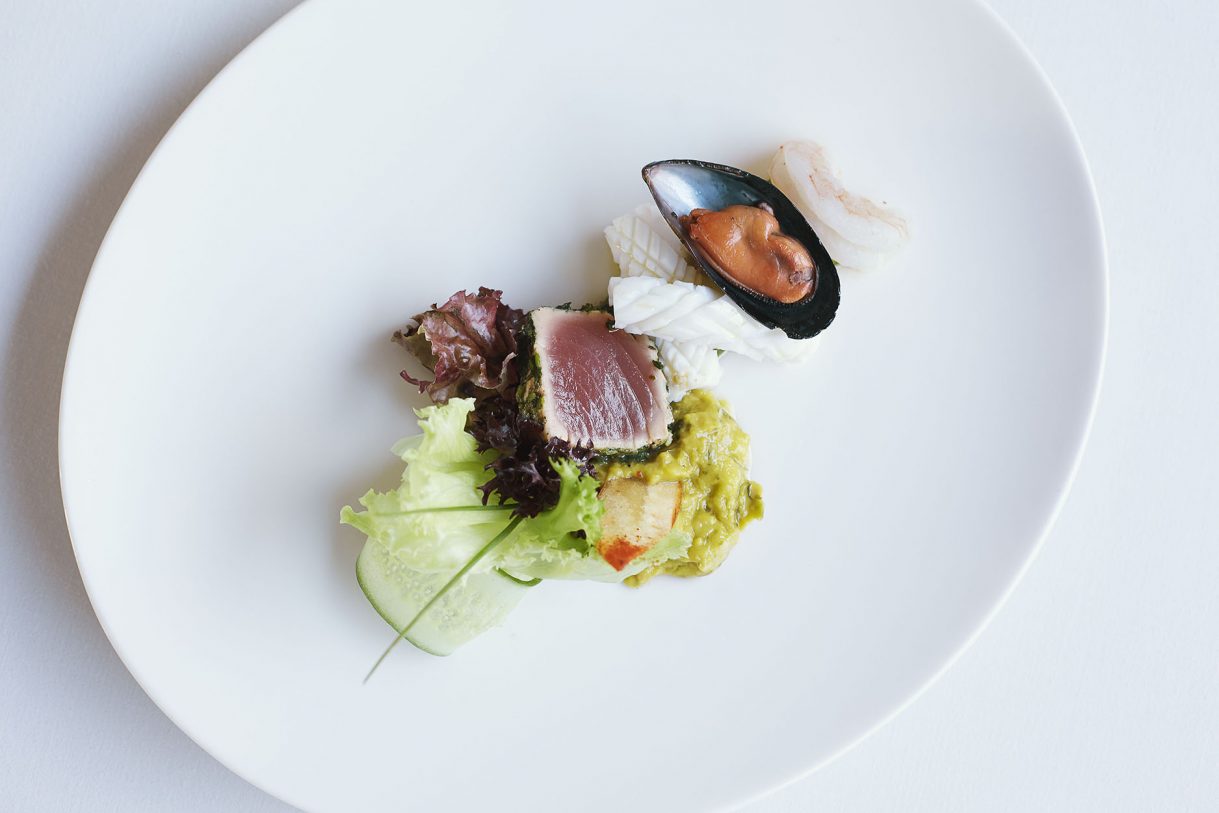
9:30pm – The old colonial feel of the Coat of Arms Bar, next to the Cinnamon Room, is our last port of call. Bawa designed the Jetwing Lighthouse hotel to resemble a ship from the seashore. As we wander out onto the terrace it really does feel as if we are on the hull of a great vessel. We look out into the darkness and spy a line of lights on the horizon. As the waiter hands us two icy arrack sours – a heady cocktail infused with local palm liquor – he explains that these horizontal illuminations belong to container ships plying the busy shipping superhighway that links the Malacca Straits with the Suez Canal. Above us the stars are out in full. It’s hard to imagine a more spectacular place in Galle for a nightcap.
DAY TWO
10:30am – After a good lie-in and breakfast, we jump in a tuk tuk for a day of local exploring. Our first stop is Handunugoda Estate, a lowland tea estate near Koggala Lake. It’s famous for white tea (although it also produces excellent black tea), which is plucked by gloved ladies and left to sun-dry. It retails for a whopping US$1500 a kilogram and is sold in exclusive tea boutiques such as Mariage Frères in Paris. Charismatic owner, Herman Gunarathne, shows us around. Over a well-rounded brew on the veranda of his estate bungalow, Herman tells us that low country tea comprises around 75% of the market and is in far greater demand (“especially in the Middle East”) than the lighter, better-known high-grown varieties. We also visit the modest tea factory, and watch as leaves are crushed, dried and sorted, and finally packed into foil-lined bags. Afterwards we enjoy a tasting session and stock up on fresh tea from their shop.
11:45am – Our next stop is Kathaluwa Puvurana Vihara. This is a thirteenth-century Buddhist temple, next to Koggala Lake ten-minutes drive from the tea factory. Although there are many temples in the area, this is one of the oldest, and stands out for its late nineteenth-century Kandyan-era murals. Uniquely, many of these depict life during the colonial period. I spot a clock with Roman numerals, a vignette of women and children wearing Victorian dress and a regal stagecoach.
12:30pm – We stop for lunch nearby, at Café Ceylon, inland from sandy Kabalana Beach. Set in a spacious tropical garden, this casual open-fronted restaurant spills onto a terrace shaded by passion fruit vines. The intriguing menu is the handiwork of German Dimaano, a Philippine-born chef, and fuses western and Asian dishes. Standouts include freshly shucked ‘Koggala Lagoon’ oysters, prawn dumplings with lunu miris sauce, and sesame-crusted tuna.
3:30pm – We work off lunch on a cycling adventure with Idle Bikes. Founded by Alex Barrett, this experienced outfit offers a variety of tours in and around the Galle area. We meet Alex at his HQ just inland from Dalawella, and opt for an easy ride, the Paddy Trail (12km). Trips aren’t always private but today it’s just us, two guides and some sturdy mountain bikes. We avoid the busy roads, instead pedalling along back lanes, paddy bunds and tracks through the Eluvila Bird Sanctuary, where we spy pied kingfishers, and villages fringed by rice fields, temples and homes. It’s a great way to get a feel for local life at a leisurely pace.
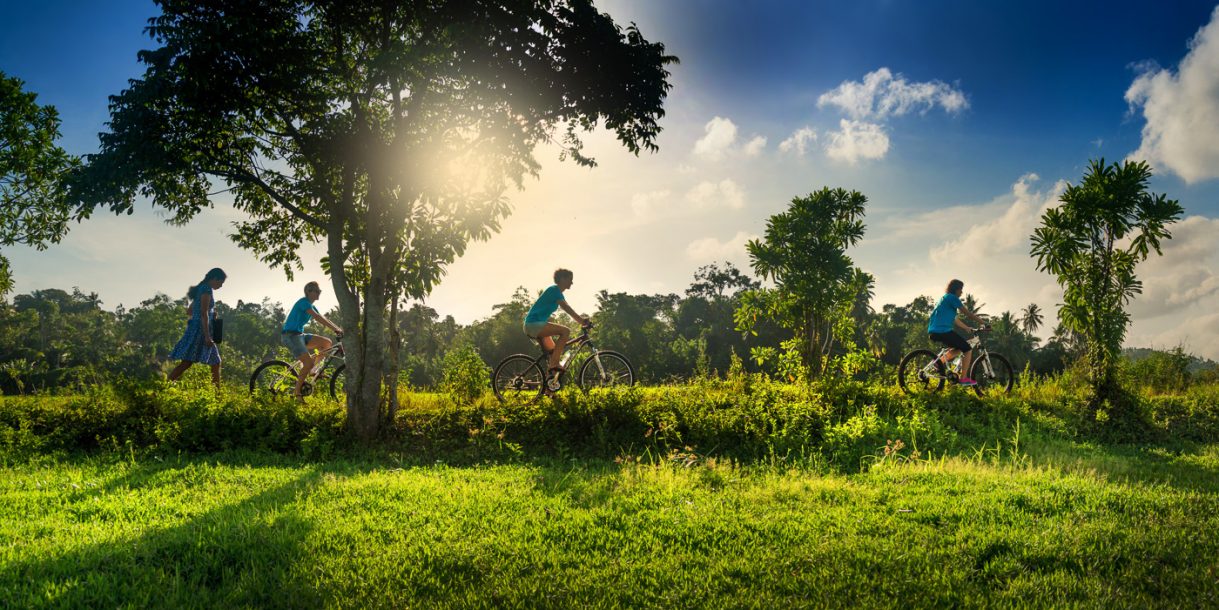
5:30pm – We end the ride at Wijeya Beach, an iconic Galle stop on an idyllic swathe of swimming beach. Its convivial and relaxed, and the drinks are reasonably priced. After a cool-down swim in the ocean we order passion fruit caipirinhas and drink them from cushioned Y-shaped loungers overlooking the beach. This is a sublime sunset spot. We watch children splashing in the shallows of the lagoon, locals fishing from sea spray-splashed rocks and barefoot kids playing impromptu games of cricket.
7:30pm – It gets dark around 6.30pm, so after sunset, we return eagerly to Jetwing Lighthouse for dinner. Tonight, we dine in Nihal’s, the small restaurant on the ground floor of adjoining sister hotel, Jetwing Lighthouse Club, with views of the ocean beyond the lower swimming pool. The restaurant is named after the hotel’s executive chef and the menu is bursting with his favourite dishes made with local ingredients, such as snake gourd, the nourishing herb ‘gotu kola’ and fresh coconut. We opt for his signature curry leaf tempered jumbo prawns (fresh from Galle fish market down the road) with cumin rice and immediately lose ourselves in the delightful complexity of flavours – a combination of fresh chilli and warm spices.
9:30pm – To earn dessert we nip back into Galle Fort and walk to Pedlar’s Inn Gelateria as we’d heard so much about the gelatos here. Produced to a cherished Italian recipe, these gelatos zing with tropical Lankan flavours such as coconut, passion fruit and banana. We opt for cups of pistachio and chocolate, and savour them from the ramparts beyond.
DAY THREE
5:30am – Sri Lanka’s southern seas are a haven for blue whales, and Mirissa, a 45-minute drive east of Galle, is the launchpad for blue whale watching trips. We’re accompanied by Anoma Alaguiawadu, Jetwing Lighthouse’s naturalist, who’s been researching whales with some of the region’s top experts since they were sighted in Mirissa around 2005. Our boat is big but not crowded, and by 7am, we are edging out of Mirissa’s vibrant harbour. The continental shelf drops off just offshore, which means that whales can be spotted 30-minutes from the coast. We’re lucky. After an hour into our journey, the team spies an impossibly large tail fin in the distance. We get closer, and yes, it’s a blue whale, and its dimensions are immense. We catch sight of its slick curved back as it breaches, and it looks like a submarine. Anoma tells us that blue whales can grow as long as 30-metres and weigh 150-tonnes, which is the equivalent of 40 elephants. We wait patiently, and at a distance, for it to resurface. After an hour, and numerous photos later, we head back to shore, accompanied on some of the journey back by a pod of some 100 acrobatic spinner dolphins.
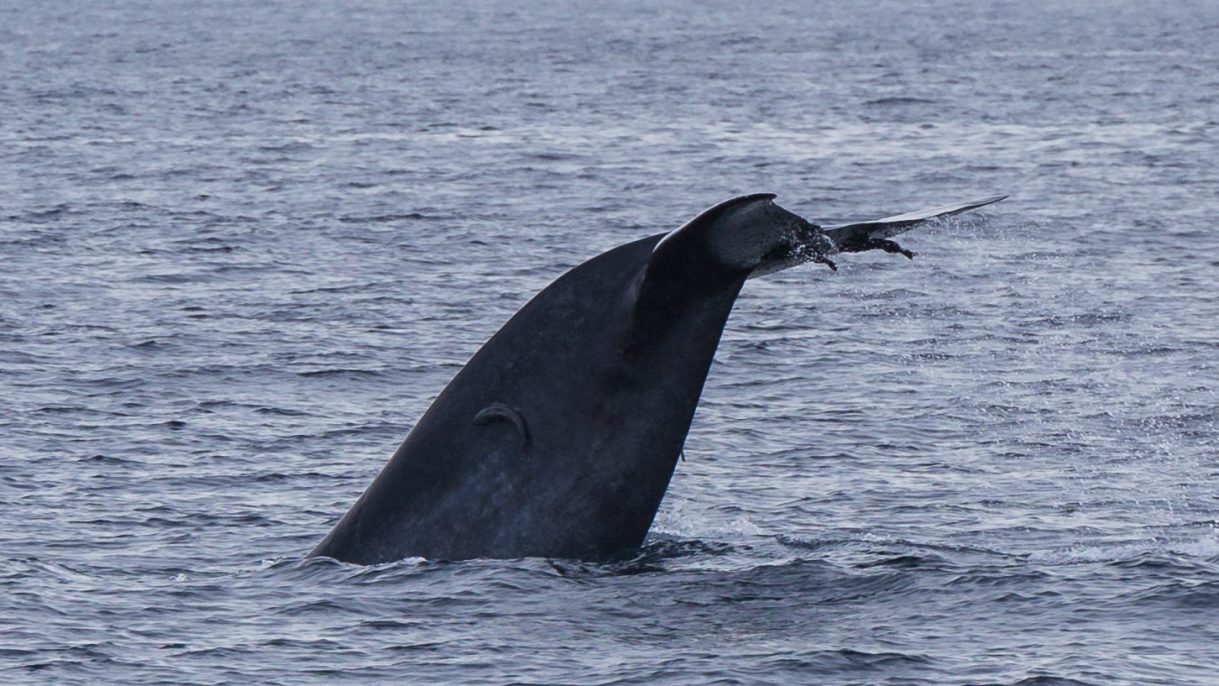
2:00pm – Our final night is at Jetwing Kurulubedha. This two-villa, six-bedroom sister-hotel of Jetwing Lighthouse is located on the banks of the Kepu Ela, a tributary of the Gin Ganga, and within walking distance. But we choose instead to travel there by boat, up the placid river, which is much more fun. Our luxurious treehouse-like room promises to be a nature lover’s dream. Located on the top floor of a freestanding building in thick foliage, its glass walls allow for maximum wildlife viewing. Endemic purple-faced leaf monkeys are frequent visitors as well as over 50 species of birds.
3:00pm – After arriving and mooring up on the hotel’s jetty, we spend the rest of the day relaxing in this exquisite eco-resort. The main pool sits above an expanse of organic rice paddies of gold-tinged grass. Rice is the staple food in Sri Lanka and approximately 1.8 million farmers are engaged in paddy cultivation. As we’re here during harvest time, we watch as they chop at the paddy with curved hand-held scythes and collect it all into sheaves.
7:30pm – The manager recommends we try a signature dining experience, so after a drink on the pool terrace, serenaded by meowing peacocks, we make our way up to The Treehouse. Secreted amid the mangroves, the Treehouse is transformed each evening with flickering candles into a magical dining destination. Here we tuck into a sublime four-course dinner involving home-smoked baby snapper for starters and modha fish fillet to follow. As we eat, we listen to crickets and splashing frogs and watch green fireflies flitting through the dark.
DAY FOUR
6:30am – We’re up early again for a dawn boat safari down the Kepu Ela in search of water birds. Anoma, the naturalist from Jetwing Lighthouse, joins us to lead the trip. He expertly points out different species of mangroves fringing the riverbanks. Of the 19 species of mangroves that exist in Sri Lanka, Anoma predicts you can see up to seven of them along this brackish river, a tributary of the Gin Ganga. Sea Mango, a type of balsa wood, also fringes the riverbank, and Anoma tells us this wood is used in mask making, a traditional craft of the southern area. On our 12-kilometre journey up to the Wakwella Bridge, passing village homes and temples, we see white-bellied sea eagles, common kingfishers, white cattle egrets, cormorants and many chirping parakeets.
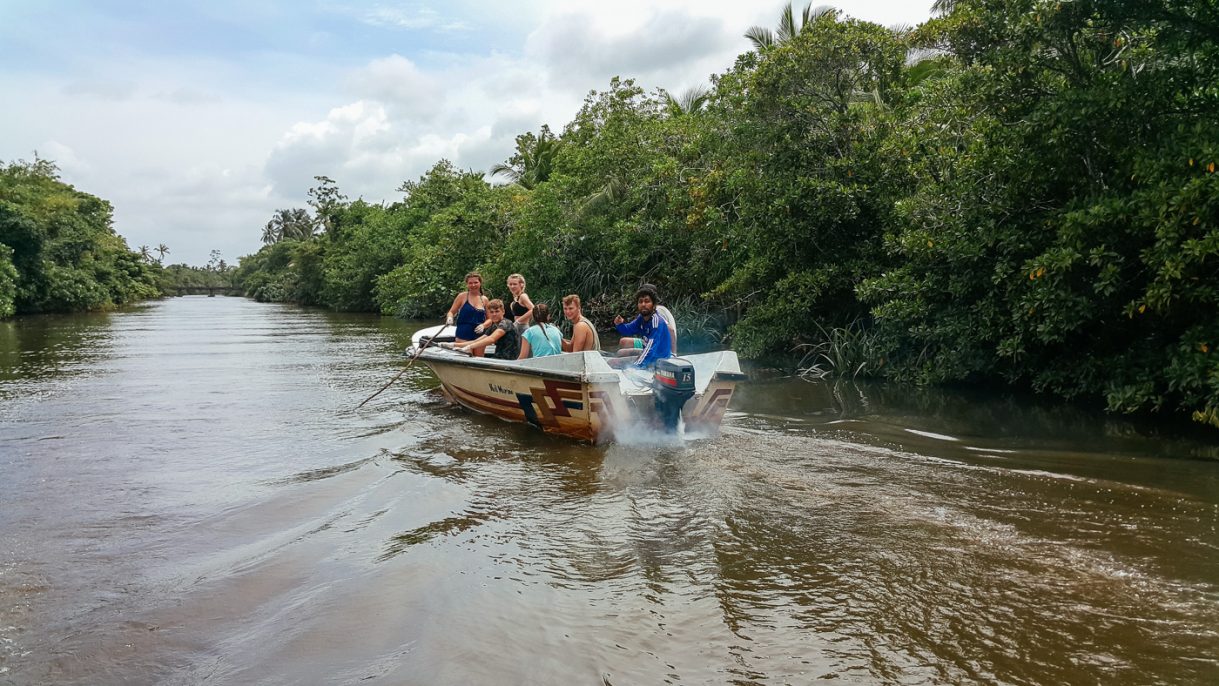
10:00am – The natural environs of Jetwing Kurulubedha make a superb place to learn about Sri Lankan cuisine. The chef is waiting for us on the pool deck as we return, beside a table bursting with local vegetables, fresh prawns, colourful spices, lentils and rice. The hotel also has a little fruit and vegetable garden, and from it we pluck striped aubergines, green chillies, and long beans. We spend the next two hours chopping, watching, sniffing, stirring and tasting, before finally sitting down to a lunch buffet of beautiful curries we had helped to cook. It’s a delicious way to pick up some tips about creating Sri Lanka’s little-known but exceptional cuisine and we leave confident that we’ll be able to recreate a little piece of Sri Lanka on our return home.
